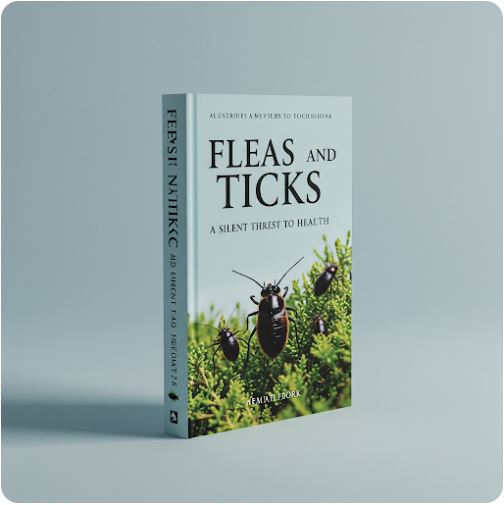Fleas and Ticks: A Silent Threat to Health
Introduction to Fleas and Ticks
"Fleas and Ticks: A Silent Threat to Health" Fleas and ticks pose significant health risks to both humans and pets. This comprehensive guide covers the life cycles, health threats, and prevention strategies for fleas and ticks, emphasizing the importance of vigilance and proactive measures for effective control. Learn how to identify signs of infestation, explore treatment options, and understand the environmental impact of these pests. Stay informed and protect your family and pets from the dangers of fleas and ticks.
The life cycle of these parasites is critical in understanding their prevalence. Fleas can reproduce rapidly, with a single female capable of laying thousands of eggs, leading to dense infestations in a short period. Their life cycle can be completed in as little as three weeks under ideal conditions, contributing to their status as relentless pests. Ticks have a different approach to reproduction; they may remain attached for several days to obtain a full blood meal, often transmitting harmful pathogens during this time. Their life cycle can span several months to years, depending on environmental conditions, making them a persistent threat.
The Health Risks Associated with Fleas
Fleas are not merely a nuisance; they pose significant health risks to both humans and pets. One of the most immediate issues stemming from a flea infestation is flea bites, which can cause considerable discomfort. These bites often lead to intense itching and irritation, prompting the affected individual to scratch the area. This act of scratching can result in secondary skin infections, exacerbating the problem and requiring medical intervention. Additionally, vulnerable individuals, such as children and elderly individuals, may experience more severe reactions to flea bites.
Furthermore, fleas can also trigger allergic reactions in some pets and humans. Flea allergy dermatitis is a common condition found in pets, particularly in dogs and cats, where a flea bite leads to an exaggerated immune response. Symptoms can include severe itching, redness, and hair loss, ultimately resulting in chronic skin issues if not treated promptly. In humans, allergic reactions might manifest as localized hives or generalized skin rashes, underscoring the need for swift action against these pests.
Moreover, fleas are known vectors for various diseases, making them a significant concern for public health. One notable example is bartonellosis, a bacterial infection transmitted through flea bites or through contact with flea feces. This disease can lead to a range of health issues, from mild flu-like symptoms to more serious complications, such as endocarditis. Although the transmission of diseases from fleas to humans is relatively rare, the potential risks warrant serious consideration, especially in highly infested environments. Overall, understanding these health risks associated with fleas is crucial in order to motivate preventive and remedial measures regarding flea control.
The Dangers of Ticks: More than Just a Bump
Ticks are often underestimated as mere nuisances, but they pose significant health risks due to their ability to transmit various diseases through their bites. Among these, Lyme disease is perhaps the most well-known, characterized by symptoms that can include fever, fatigue, and a distinctive rash resembling a “bull's-eye.” Without proper treatment, Lyme disease can lead to serious complications affecting the joints, heart, and nervous system. Another notable illness spread by ticks is Rocky Mountain spotted fever (RMSF), which emerges after a bite from an infected tick, leading to symptoms like high fever, severe headache, and rash. If left untreated, RMSF can be fatal; thus, recognizing tick bites early is crucial.
Anaplasmosis is another tick-borne disease that has garnered attention in recent years. Caused by the bacterium Anaplasma phagocytophilum, this disease can lead to fever, chills, and muscle aches. Like Lyme disease and RMSF, timely recognition and treatment are essential to prevent severe health implications. Ticks attach themselves to hosts by using specialized mouthparts to latch onto the skin, often remaining undetected for hours or even days as they feed on blood. Understanding the behavior of ticks—such as their preference for wooded or grassy areas—can assist individuals in avoiding exposure during outdoor activities.
Recognizing ticks is a vital part of prevention. They can range in size, from a pinhead to a small bean, and can vary in color, often being gray or brown. By being vigilant after spending time in natural environments, individuals can check for ticks promptly, ensuring early detection. The application of preventive measures, such as using insect repellent and wearing protective clothing, can significantly reduce the risk of tick bites and the corresponding health threats associated with them.
Signs of Infestation: How to Identify Fleas and Ticks
Identifying fleas and ticks in your environment and on pets is essential for preventing severe health issues. These pests can pose significant risks not only to animals but also to humans. Recognizing the signs of an infestation allows for timely intervention and treatment.
When it comes to spotting fleas on pets, one predominant indicator is the presence of flea dirt—tiny black specks that resemble pepper—found on the pet’s skin or within its fur. If you notice your pet scratching or biting at its skin more than usual, it could be an indication of a flea infestation. Fleas often inhabit warm, dark areas, so checking the fur near the ears, tail base, and belly is advisable, as these are common places for fleas to hide.
Tick detection requires a different approach as these parasites tend to latch onto their host. When inspecting yourself or others, one should look for small, dark bumps on the skin that may indicate a tick has attached itself. Regularly examining areas such as behind the ears, under the arms, and along the hairline can be helpful. Ticks can transmit Lyme disease and other serious illnesses, making it vital to remove them promptly using fine-tipped tweezers.
Additionally, being aware of flea and tick bites is crucial for early intervention. Typically, flea bites appear as small red bumps with a halo, while tick bites can sometimes lead to a more significant rash. If you experience any unusual symptoms following a bite or notice changes in your pet’s behavior, seeking professional advice is recommended. Knowing the signs of infestation can lead to more effective control measures and ensure the well-being of both pets and humans alike.
Prevention Strategies: Keeping Your Home and Pets Safe
Fleas and ticks pose significant health risks to pets and humans alike. Their prevention requires a multi-faceted approach that incorporates regular grooming of pets, effective use of preventive treatments, maintaining a clean home environment, and diligent yard maintenance.
Regular grooming plays a critical role in controlling flea and tick populations on pets. Frequent brushing helps to remove any potential pests present in the fur while also allowing for early detection of infestations. Bathing pets with a vet-recommended flea and tick shampoo further aids in eliminating these pests and provides an opportunity to apply topical preventive treatments, such as spot-on solutions or oral medications specifically designed to repel and kill fleas and ticks.
In addition to grooming, using preventive treatments is essential to protect pets year-round. Various options are available, including topical treatments, collars, and oral medications. Each method has its advantages, and pet owners should consult their veterinarian to determine the most suitable option based on their pet's health, lifestyle, and geographical . It's worth noting that some regions have higher flea and tick activity, which may necessitate more rigorous prevention strategies.
Maintaining a clean indoor environment is equally important in preventing infestations. Regular vacuuming of carpets, rugs, and upholstery helps eliminate flea eggs and larvae. Additionally, washing pet bedding and any fabrics frequently contacted by pets can significantly reduce the risk of flea and tick presence. Utilizing flea sprays or powders designed for home use can further bolster efforts to keep living spaces safe.
Yard maintenance is another critical component of preventing flea and tick populations. Keeping grass mowed and shrubs trimmed can reduce areas where these pests thrive. Additionally, creating a barrier of wood chips or gravel between gardens and grassy areas can minimize the chances of fleas and ticks migrating into outdoor living spaces. Incorporating these strategic preventive measures will greatly contribute to the well-being of both pets and humans in the household.
Treatment Options: What to Do When You Find Fleas or Ticks
When confronted with a flea or tick infestation, immediate action is paramount to protect both pets and the home environment. A comprehensive approach that includes home remedies, over-the-counter products, and veterinary treatments can effectively eliminate these parasites.
Home remedies can serve as a first line of defense against fleas and ticks. Common solutions include a mixture of water and vinegar, as the acidity can deter these pests. Additionally, the use of diatomaceous earth — a fine powder made from fossilized algae — can be sprinkled in areas where fleas are likely to dwell. This natural remedy works by dehydrating the insects, aiding in their eradication. Regular vacuuming is also essential, as it removes eggs and larvae from carpets and upholstery.
For more immediate and powerful effects, over-the-counter products can be utilized. Topical treatments and spot-ons designed for pets can provide swift relief from flea and tick bites. Many of these formulations contain insecticides that target the nervous systems of these parasites. It is crucial to follow the manufacturer's instructions carefully to ensure safety and effectiveness. Flea collars are another popular option, slowly releasing their active ingredients to repel pests, though their effectiveness may vary among different pet breeds.
In cases of severe infestations, seeking veterinary assistance is recommended. Vets can prescribe stronger medication, such as oral treatments that provide systemic protection against fleas and ticks. These prescriptions often offer longer-lasting effects than over-the-counter products. Furthermore, professional pest control can be employed to treat the home environment, ensuring that all areas, including yards and gardens, are treated by specialized equipment designed to eradicate infestations thoroughly.
Taking these steps will not only relieve affected pets but also create a healthier living environment, effectively addressing the silent threat of fleas and ticks.
The Environmental Impact of Fleas and Ticks
Fleas and ticks are often viewed solely as nuisances that affect household pets and human beings. However, their role extends beyond mere infestation. These ectoparasites are integral components of various ecosystems, where they serve as food sources for numerous species and play a role in biological control. Fleas primarily feed on mammals, while ticks can be found on various hosts including mammals, birds, and reptiles. This feeding behavior influences not just their hosts but also the broader food web, as they are a key source of nutrition for many predators.
The presence of fleas and ticks can significantly impact wildlife populations. For instance, high infestations can weaken individual animals, making them more susceptible to disease or predation. This vulnerability can lead to decreased populations of certain species, which may in turn alter ecosystem dynamics. In addition, ticks are known vectors for various diseases that can affect wildlife, such as Lyme disease and anaplasmosis, prompting a cascading effect on predator and prey relationships. When wildlife populations are affected by these parasites, the ramifications can extend to humans, as zoonotic diseases can emerge, potentially leading to public health concerns.
In urban areas, the presence of flea and tick populations can affect human activities such as outdoor recreation and tourism. People who engage in recreational activities, like hiking or camping, may encounter these pests, leading to potential health risks. Awareness of these consequences is essential for fostering a more comprehensive understanding of both fleas and ticks and their influence on public health. Furthermore, effective management strategies that consider their environmental impact are crucial for maintaining the balance within ecosystems while safeguarding human health. The intricate relationship between fleas, ticks, and their surroundings underscores the need for continued research and awareness in order to mitigate the silent threats they pose.
Common Myths vs. Facts about Fleas and Ticks
Fleas and ticks, despite their minuscule size, have a significant impact on both pet and human health. Numerous myths surrounding these parasites can lead to ineffective prevention strategies. One prevalent myth is that fleas and ticks are primarily a summer problem. While it is true that these pests are more active in warmer months, they can survive in homes, pet bedding, and outdoor settings throughout the year. This survival depends on environmental conditions, allowing them to thrive even during colder periods.
Another common misconception is that fleas and ticks only inhabit grassy or wooded areas. In reality, these parasites can venture into urban environments and residential areas. Fleas typically reside in carpets, rugs, and upholstery, while ticks can be found in backyards, even in well-manicured lawns. The notion that keeping a clean home or a well-maintained yard will eliminate the risk of infestation is misleading. Comprehensive prevention strategies must encompass both indoor and outdoor environments.
Additionally, many pet owners believe that over-the-counter remedies are sufficient for flea and tick control. While some may provide temporary relief, they often lack the potency necessary to fully eradicate these pests. Prescription treatments prescribed by veterinarians are often more effective, as they target the life cycle of fleas and ticks, preventing future infestations. Relying solely on natural remedies, such as essential oils, may not provide the lasting protection that pets require.
Education is crucial in debunking these myths, as misconceptions can lead to inadequate measures in managing fleas and ticks. A comprehensive understanding of their habits, habitats, and effective treatment options is essential in safeguarding both pets and humans from the potentially hazardous impacts of these pervasive pests.
Conclusion: Staying Vigilant Against Fleas and Ticks
Fleas and ticks represent a significant health concern for both humans and pets. Throughout this blog post, we have explored the various impacts these parasites can have, ranging from disease transmission to allergic reactions. The evidence underscores the necessity of being proactive in the fight against these silent threats. Understanding the life cycles, habits, and the environments that harbor fleas and ticks is crucial in devising effective prevention strategies.
Regular inspection of pets and living spaces is critical to mitigating the risks associated with fleas and ticks. These parasites can quickly infest homes and yards, which makes early detection key. By incorporating preventative treatments, such as topical medications and flea collars, and maintaining cleanliness and hygiene, pet owners can significantly reduce the likelihood of an infestation. Furthermore, engaging with veterinary professionals for guidance on appropriate preventive measures will ensure that both pet and human health are safeguarded.
It is essential to be aware of the fact that fleas and ticks are not merely nuisances but can cause serious health issues if left uncontrolled. The various diseases attributable to these parasites, including Lyme disease and fleas-induced anemia, highlight the importance of vigilance among pet owners and families. As such, being informed and proactive can go a long way in eliminating their threat.
In conclusion, taking action against fleas and ticks not only protects our pets but also significantly contributes to the overall well-being of our families. By remaining vigilant, practicing preventive measures, and fostering awareness, we can effectively combat this silent threat and promote a healthier environment for everyone involved.
Loja de Livros
Ofertas | Para Você | Mais Vendidos | Lançamentos | Indicações | Kindle Unlimited | eBooks Kindle | Livros Usados | Audible




















